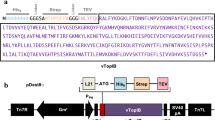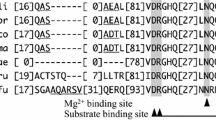Abstract
The KOD DNA polymerase from Thermococcus kodakarensis (Tkod-Pol) has been preferred for PCR due to its rapid elongation rate, extreme thermostability and outstanding fidelity. Here in this study, we utilized silkworm-baculovirus expression vector system (silkworm-BEVS) to express the recombinant Tkod-Pol (rKOD) with N-terminal (rKOD-N) or C-terminal (rKOD-C) tandem fusion tags. By using BEVS, we produced functional rKODs with satisfactory yields, about 1.1 mg/larva for rKOD-N and 0.25 mg/larva for rKOD-C, respectively. Interestingly, we found that rKOD-C shows higher thermostability at 95 °C than that of rKOD-N, while that rKOD-N is significantly unstable after exposing to long period of heat-shock. We also assessed the polymerase activity as well as the fidelity of purified rKODs under various conditions. Compared with commercially available rKOD, which is expressed in E. coli expression system, rKOD-C exhibited almost the same PCR performance as the commercial rKOD did, while rKOD-N did lower performance. Taken together, our results suggested that silkworm-BEVS can be used to express and purify efficient rKOD in a commercial way.





Similar content being viewed by others
References
Burgers, P. M., Koonin, E. V., Bruford, E., Blanco, L., Burtis, K. C., Christman, M. F., et al. (2001). Eukaryotic DNA polymerases: Proposal for a revised nomenclature. Journal of Biological Chemistry, 276, 43487–43490.
Makarova, K. S., & Koonin, E. V. (2013). Archaeology of eukaryotic DNA replication. Cold Spring Harbor Perspectives Biology, 5, a012963.
Krupovic, M., Makarova, K. S., Forterre, P., Prangishvili, D., & Koonin, E. V. (2014). Casposons: A new superfamily of self-synthesizing DNA transposons at the origin of prokaryotic CRISPR-Cas immunity. BMC Biology, 12, 36.
Lundberg, K. S., Shoemaker, D. D., Adams, M. W., Short, J. M., Sorge, J. A., & Mathur, E. J. (1991). High-fidelity amplification using a thermostable DNA polymerase isolated from Pyrococcus furiosus. Gene, 108, 1–6.
Cline, J., Braman, J. C., & Hogrefe, H. H. (1996). PCR fidelity of Pfu DNA polymerase and other thermostable DNA polymerases. Nucleic Acids Research, 24, 3546–3551.
Takagi, M., Nishioka, M., Kakihara, H., Kitabayashi, M., Inoue, H., Kawakami, B., et al. (1997). Characterization of DNA polymerase from Pyrococcus sp. strain KOD1 and its application to PCR. Applied Environmental Microbiology, 63, 4504–4510.
Lu, C., & Erickson, H. P. (1997). Expression in Escherichia coli of the thermostable DNA polymerase from Pyrococcus furiosus. Protein Expression and Purification, 11, 179–184.
Sun, Z., & Cai, J. (2006). Purification of recombinant Pfu DNA polymerase using a new JK110 resin. Korean Journal of Chemical Engineering, 23, 607–609.
Niimi, H., Mori, M., Tabata, H., Minami, H., Ueno, T., Hayashi, S., et al. (2011). A novel eukaryote-made thermostable DNA polymerase which is free from bacterial DNA contamination. Journal of Clinical Microbiology, 49, 3316–3320.
Miladi, B., Dridi, C., El Marjou, A., Boeuf, G., Bouallagui, H., Dufour, F., et al. (2013). An improved strategy for easy process monitoring and advanced purification of recombinant proteins. Molecular Biotechnology, 55, 227–235.
Hu, J. H., Wang, F., & Liu, C. Z. (2015). Development of an efficient process intensification strategy for enhancing Pfu DNA polymerase production in recombinant Escherichia coli. Bioprocess and Biosystems Engineering, 38, 651–659.
Ishino, Y., Iwasaki, H., Kato, I., & Shinagawa, H. (1994). Amino-acid-sequence motifs essential to 3′–5′ exonuclease activity of Escherichia coli DNA polymerase II. Journal of Biological Chemistry, 269, 14655–14660.
Biles, B. D., & Connolly, B. A. (2004). Low-fidelity Pyrococcus furiosus DNA polymerase mutants useful in error-prone PCR. Nucleic Acids Research, 32, e176.
Nørholm, M. H. H. (2010). A mutant Pfu DNA polymerase designed for advanced uracil-excision DNA engineering. BMC Biotechnology, 10, 21.
Yamagami, T., Ishino, S., Kawarabayasi, Y., & Ishino, Y. (2014). Mutant Taq DNA polymerases with improved elongation ability as a useful reagent for genetic engineering. Frontiers in Microbiology, 5, 461.
Ppyun, H., Kim, S. H., Youn, M. H., Cho, S. S., Kwon, K. M., Kweon, D. H., et al. (2016). Improved PCR performance and fidelity of double mutant Neq A523R/N540R DNA polymerase. Enzyme and Microbial Technology, 82, 197–204.
Elshawadfy, A. M., Keith, B. J., Ee Ooi, H., Kinsman, T., Heslop, P., & Connolly, B. A. (2014). DNA polymerase hybrids derived from the family-B enzymes of Pyrococcus furiosus and Thermococcus kodakarensis: Improving performance in the polymerase chain reaction. Frontiers in Microbiology, 5, 224.
Kitabayashi, M., Nishiya, Y., Esaka, M., Itakura, M., & Imanaka, T. (2002). Gene cloning and polymerase chain reaction with proliferating cell nuclear antigen from Thermococcus kodakaraensis KOD1. Bioscience, Biotechnology, and Biochemistry, 66, 2194–2200.
Wang, Y., Prosen, D. E., Mei, L., Sullivan, J. C., Finney, M., & Vander Horn, P. B. (2004). A novel strategy to engineer DNA polymerases for enhanced processivity and improved performance in vitro. Nucleic Acids Research, 32, 1197–1207.
Lawyer, F. C., Stoffel, S., Saiki, R. K., Myambo, K., Drummond, R., & Gelfand, D. H. (1989). Isolation, characterization, and expression in Escherichia coli of the DNA polymerase gene from Thermus aquaticus. Journal of Biological Chemistry, 264, 6427–6437.
Mroczkowski, B. S., Huvar, A., Lernhardt, W., Misono, K., Nielson, K., & Scott, B. (1994). Secretion of thermostable DNA-polymerase using a novel baculovirus vector. Journal of Biological Chemistry, 269, 13522–13528.
Angers, M., Cloutier, J. F., Castonguay, A., & Drouin, R. (2001). Optimal conditions to use Pfu exo(−) DNA polymerase for highly efficient ligation-mediated polymerase chain reaction protocols. Nucleic Acids Research, 29, E83.
Kato, T., Kajikawa, M., Maenaka, K., & Park, E. Y. (2010). Silkworm expression system as a platform technology in life science. Applied Microbiology and Biotechnology, 85, 459–470.
Ono, C., Nakatsukasa, T., Nishijima, Y., Asano, S.-I., Sahara, K., & Bando, H. (2007). Construction of the BmNPV T3 bacmid system and its application to the functional analysis of BmNPV he65. Journal of Insect Biotechnology and Sericology, 76, 161–167.
O’Reilly, D. R., Miller, L., & Luckow, V. A. (1992). Baculovirus expression vectors: A laboratory manual (pp. 216–234). New York: Oxford University Press.
Masuda, A., Xu, J., Mitsudome, T., Morokuma, D., Mon, H., Banno, Y., et al. (2015). Improvement of Endo-β-N-acetylglucosaminidase H production using silkworm-baculovirus protein expression system. Journal of Asia-Pacific Entomology, 18, 175–180.
Xu, J., Zhang, P., Kusakabe, T., Mon, H., Li, Z., Zhu, L., et al. (2015). Comparative proteomic analysis of hemolymph proteins from Autographa californica multiple nucleopolyhedrovirus (AcMNPV)-sensitive or -resistant silkworm strains during infections. Comparative Biochemistry and Physiology Part D: Genomics Proteomics, 16, 36–47.
Bergen, K., Betz, K., Welte, W., Diederichs, K., & Marx, A. (2013). Structures of KOD and 9 degrees N DNA polymerases complexed with primer template duplex. ChemBioChem, 14, 1058–1062.
Maesaki, R., Satoh, R., Taoka, M., Kanaba, T., Asano, T., Fujita, C., et al. (2014). Efficient and cost effective production of active-form human PKB using silkworm larvae. Scientific Reports, 4, 6016.
Toth, A. M., Kuo, C.-W., Khoo, K.-H., & Jarvis, D. L. (2014). A new insect cell glycoengineering approach provides baculovirus-inducible glycogene expression and increases human-type glycosylation efficiency. Journal of Biotechnology, 182–183, 19–29.
Mabashi-Asazuma, H., Kuo, C.-W., Khoo, K.-H., & Jarvis, D. L. (2014). A novel baculovirus vector for the production of nonfucosylated recombinant glycoproteins in insect cells. Glycobiology, 24, 325–340.
Berger, I., Fitzgerald, D. J., & Richmond, T. J. (2004). Baculovirus expression system for heterologous multiprotein complexes. Nature Biotechnology, 22, 1583–1587.
Mansouri, M., Bellon-Echeverria, I., Rizk, A., Ehsaei, Z., Cianciolo Cosentino, C., Silva, C. S., et al. (2016). Highly efficient baculovirus-mediated multigene delivery in primary cells. Nature Communications, 7, 11529.
Lee, J. M., Mon, H., Banno, Y., Iiyama, K., & Takahiro, K. (2012). Bombyx mori strains useful for efficient recombinant protein production using a baculovirus vector. Journal of Biotechnology and Biomaterials, S9, 003.
Mon, H., Lee, J., Fukushima, M., Nagata, Y., Fujii, M., Xu, J., et al. (2013). Production and characterization of the celery mismatch endonuclease CEL II using baculovirus/silkworm expression system. Applied Microbiology and Biotechnology, 97, 6813–6822.
Mitsudome, T., Xu, J., Nagata, Y., Masuda, A., Iiyama, K., Morokuma, D., et al. (2014). Expression, purification, and characterization of endo-β-N-acetylglucosaminidase H using baculovirus-mediated silkworm protein expression system. Applied Biochemistry and Biotechnology, 172, 3978–3988.
Mitsudome, T., Mon, H., Xu, J., Li, Z., Lee, J. M., Patil, A. A., et al. (2015). Biochemical characterization of maintenance DNA methyltransferase DNMT-1 from silkworm, Bombyx mori. Insect Biochemistry and Molecular Biology, 58, 55–65.
Masuda, A., Xu, J., Mitsudome, T., Nagata, Y., Morokuma, D., Mon, H., et al. (2015). Mass production of an active peptide-N-glycosidase F using silkworm-baculovirus expression system. Molecular Biotechnology, 57, 735–745.
Morokuma, D., Xu, J., Mon, H., Hirata, K., Hino, M., Kuboe, S., et al. (2015). Human alpha 1-acid glycoprotein as a model protein for glycoanalysis in baculovirus expression vector system. Journal of Asia-Pacific Entomology, 18, 303–309.
El-Deiry, W. S., Downey, K. M., & So, A. G. (1984). Molecular mechanisms of manganese mutagenesis. Proceedings of the National Academy of Sciences of the United States of America, 81, 7378–7382.
Nishioka, M., Mizuguchi, H., Fujiwara, S., Komatsubara, S., Kitabayashi, M., Uemura, H., et al. (2001). Long and accurate PCR with a mixture of KOD DNA polymerase and its exonuclease deficient mutant enzyme. Journal of Biotechnology, 88, 141–149.
Kuroita, T., Matsumura, H., Yokota, N., Kitabayashi, M., Hashimoto, H., Inoue, T., et al. (2005). Structural mechanism for coordination of proofreading and polymerase activities in archaeal DNA polymerases. Journal of Molecular Biology, 351, 291–298.
Acknowledgements
We thank Dr. Imanishi (National Institute of Agrobiological Sciences, Japan) for providing the NIAS-Bm-oyanagi2 (BmO2) cell line.
Author information
Authors and Affiliations
Corresponding authors
Ethics declarations
Conflict of interest
The authors declare that they have no conflict of interest.
Electronic supplementary material
Below is the link to the electronic supplementary material.
Rights and permissions
About this article
Cite this article
Yamashita, M., Xu, J., Morokuma, D. et al. Characterization of Recombinant Thermococcus kodakaraensis (KOD) DNA Polymerases Produced Using Silkworm-Baculovirus Expression Vector System. Mol Biotechnol 59, 221–233 (2017). https://doi.org/10.1007/s12033-017-0008-9
Published:
Issue Date:
DOI: https://doi.org/10.1007/s12033-017-0008-9




